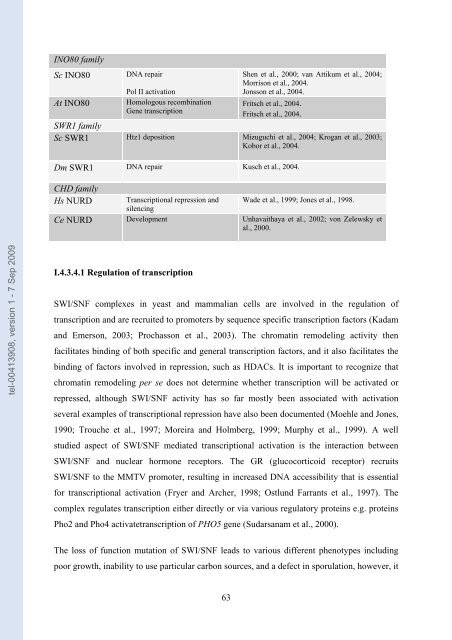Etudes sur le mécanisme de remodelage des nucléosomes par ...
Etudes sur le mécanisme de remodelage des nucléosomes par ...
Etudes sur le mécanisme de remodelage des nucléosomes par ...
Create successful ePaper yourself
Turn your PDF publications into a flip-book with our unique Google optimized e-Paper software.
tel-00413908, version 1 - 7 Sep 2009<br />
INO80 family<br />
Sc INO80 DNA repair<br />
Shen et al., 2000; van Attikum et al., 2004;<br />
Morrison et al., 2004.<br />
Pol II activation<br />
Jonsson et al., 2004.<br />
At INO80<br />
SWR1 family<br />
Homologous recombination<br />
Gene transcription<br />
Fritsch et al., 2004.<br />
Fritsch et al., 2004.<br />
Sc SWR1 Htz1 <strong>de</strong>position Mizuguchi et al., 2004; Krogan et al., 2003;<br />
Kobor et al., 2004.<br />
Dm SWR1 DNA repair Kusch et al., 2004.<br />
CHD family<br />
Hs NURD<br />
Ce NURD<br />
Transcriptional repression and<br />
si<strong>le</strong>ncing<br />
Development<br />
I.4.3.4.1 Regulation of transcription<br />
63<br />
Wa<strong>de</strong> et al., 1999; Jones et al., 1998.<br />
Unhavaithaya et al., 2002; von Ze<strong>le</strong>wsky et<br />
al., 2000.<br />
SWI/SNF comp<strong>le</strong>xes in yeast and mammalian cells are involved in the regulation of<br />
transcription and are recruited to promoters by sequence specific transcription factors (Kadam<br />
and Emerson, 2003; Prochasson et al., 2003). The chromatin remo<strong>de</strong>ling activity then<br />
facilitates binding of both specific and general transcription factors, and it also facilitates the<br />
binding of factors involved in repression, such as HDACs. It is important to recognize that<br />
chromatin remo<strong>de</strong>ling per se does not <strong>de</strong>termine whether transcription will be activated or<br />
repressed, although SWI/SNF activity has so far mostly been associated with activation<br />
several examp<strong>le</strong>s of transcriptional repression have also been documented (Moeh<strong>le</strong> and Jones,<br />
1990; Trouche et al., 1997; Moreira and Holmberg, 1999; Murphy et al., 1999). A well<br />
studied aspect of SWI/SNF mediated transcriptional activation is the interaction between<br />
SWI/SNF and nuc<strong>le</strong>ar hormone receptors. The GR (glucocorticoid receptor) recruits<br />
SWI/SNF to the MMTV promoter, resulting in increased DNA accessibility that is essential<br />
for transcriptional activation (Fryer and Archer, 1998; Ostlund Farrants et al., 1997). The<br />
comp<strong>le</strong>x regulates transcription either directly or via various regulatory proteins e.g. proteins<br />
Pho2 and Pho4 activatetranscription of PHO5 gene (Sudarsanam et al., 2000).<br />
The loss of function mutation of SWI/SNF <strong>le</strong>ads to various different phenotypes including<br />
poor growth, inability to use <strong>par</strong>ticular carbon sources, and a <strong>de</strong>fect in sporulation, however, it

















